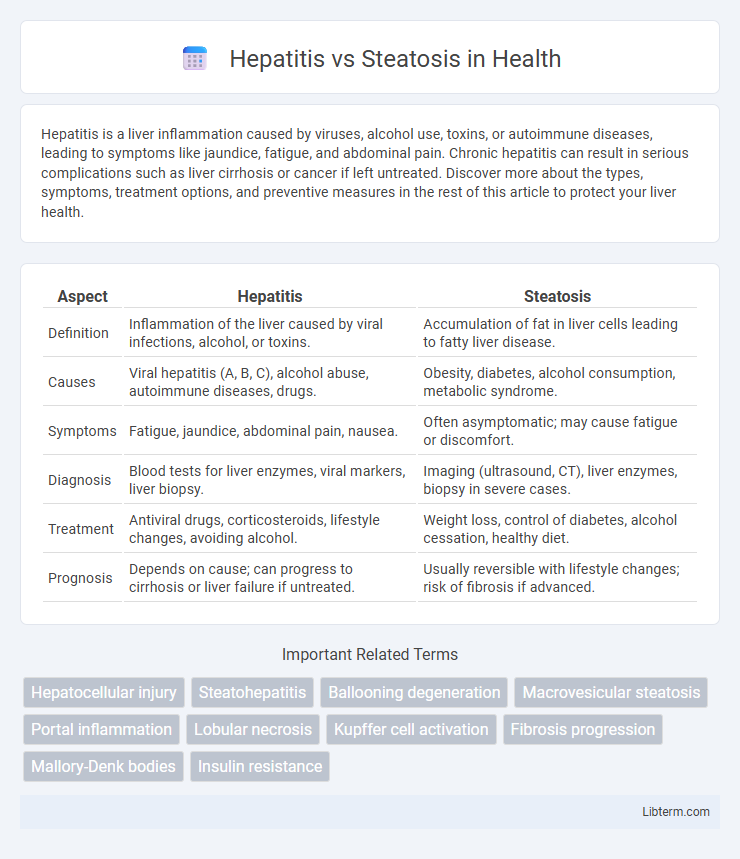Hepatitis is a liver inflammation caused by viruses, alcohol use, toxins, or autoimmune diseases, leading to symptoms like jaundice, fatigue, and abdominal pain. Chronic hepatitis can result in serious complications such as liver cirrhosis or cancer if left untreated. Discover more about the types, symptoms, treatment options, and preventive measures in the rest of this article to protect your liver health.
Table of Comparison
| Aspect | Hepatitis | Steatosis |
|---|---|---|
| Definition | Inflammation of the liver caused by viral infections, alcohol, or toxins. | Accumulation of fat in liver cells leading to fatty liver disease. |
| Causes | Viral hepatitis (A, B, C), alcohol abuse, autoimmune diseases, drugs. | Obesity, diabetes, alcohol consumption, metabolic syndrome. |
| Symptoms | Fatigue, jaundice, abdominal pain, nausea. | Often asymptomatic; may cause fatigue or discomfort. |
| Diagnosis | Blood tests for liver enzymes, viral markers, liver biopsy. | Imaging (ultrasound, CT), liver enzymes, biopsy in severe cases. |
| Treatment | Antiviral drugs, corticosteroids, lifestyle changes, avoiding alcohol. | Weight loss, control of diabetes, alcohol cessation, healthy diet. |
| Prognosis | Depends on cause; can progress to cirrhosis or liver failure if untreated. | Usually reversible with lifestyle changes; risk of fibrosis if advanced. |
Introduction to Hepatitis and Steatosis
Hepatitis is an inflammatory condition of the liver caused primarily by viral infections, autoimmune disorders, or toxic substances, leading to liver cell damage and impaired function. Steatosis, also known as fatty liver disease, involves the accumulation of excess fat in liver cells, often linked to obesity, diabetes, and excessive alcohol consumption. Both conditions significantly impact liver health but differ in etiology, pathophysiology, and treatment approaches.
Definition and Key Differences
Hepatitis is an inflammation of the liver caused by viral infections, autoimmune diseases, or toxins, characterized by liver cell injury and elevated liver enzymes. Steatosis, also known as fatty liver disease, involves abnormal accumulation of fat within liver cells, often linked to obesity, diabetes, or alcohol consumption. Key differences include hepatitis primarily being an inflammatory condition with potential liver damage, while steatosis is a metabolic disorder marked by fat buildup without initial inflammation.
Causes of Hepatitis
Hepatitis is primarily caused by viral infections such as hepatitis A, B, C, D, and E viruses, with hepatitis B and C being the most common chronic forms leading to liver damage. Other causes include autoimmune diseases, excessive alcohol consumption, certain medications, and toxins, which trigger inflammation of the liver tissue. Unlike steatosis, which results from fat accumulation due to metabolic syndromes or alcohol abuse, hepatitis directly involves liver inflammation caused by infectious or immune-mediated agents.
Causes of Steatosis
Steatosis, commonly known as fatty liver disease, primarily results from excessive alcohol consumption, obesity, insulin resistance, and metabolic syndrome, which lead to abnormal fat accumulation in liver cells. Non-alcoholic fatty liver disease (NAFLD) is strongly associated with type 2 diabetes and dyslipidemia, causing hepatic steatosis due to disrupted lipid metabolism. Unlike hepatitis, which is primarily caused by viral infections such as hepatitis A, B, and C viruses, steatosis is mainly driven by metabolic and lifestyle factors that impair fat processing in the liver.
Symptoms: Comparing Hepatitis and Steatosis
Hepatitis symptoms commonly include fatigue, jaundice, abdominal pain, and dark urine, reflecting liver inflammation and impaired function. Steatosis, or fatty liver disease, often presents with mild or no symptoms but may cause fatigue and discomfort in the upper right abdomen due to fat accumulation. Distinguishing between these conditions relies on symptom severity and diagnostic imaging or liver function tests to assess inflammation versus fat deposition.
Diagnosis: Tests and Procedures
Diagnosis of hepatitis primarily involves blood tests such as liver function tests (LFTs), viral serologies for hepatitis A, B, and C, and autoimmune markers, along with liver ultrasound or biopsy to assess inflammation and liver damage. Steatosis, or fatty liver disease, is diagnosed using imaging techniques like ultrasound, CT scan, or MRI to detect fat accumulation, complemented by liver enzyme tests and sometimes a liver biopsy for confirmation. FibroScan is increasingly used for non-invasive assessment of liver fibrosis in both conditions.
Treatment Options for Hepatitis
Hepatitis treatment options vary based on the type and cause, with antiviral medications like interferons and direct-acting antivirals used for viral hepatitis B and C to reduce liver inflammation and prevent progression. In autoimmune hepatitis, corticosteroids and immunosuppressants help control immune response and liver damage. Supportive care including lifestyle changes, avoiding alcohol, and monitoring liver function is essential for managing hepatitis and preventing complications.
Treatment Strategies for Steatosis
Treatment strategies for steatosis primarily involve lifestyle modifications such as dietary changes, increased physical activity, and weight loss to reduce liver fat accumulation. Pharmacological interventions, including insulin sensitizers like pioglitazone and antioxidants such as vitamin E, may be prescribed for non-alcoholic steatohepatitis (NASH) to prevent disease progression. Management also requires controlling underlying metabolic conditions like diabetes, hyperlipidemia, and hypertension to improve liver function and prevent steatosis-related complications.
Prevention and Lifestyle Modifications
Preventing hepatitis involves vaccination against hepatitis A and B, practicing safe sex, avoiding sharing needles, and maintaining proper hygiene to reduce viral transmission risk. Steatosis prevention relies on lifestyle modifications such as adopting a balanced diet low in saturated fats and sugars, engaging in regular physical activity to maintain a healthy weight, and limiting alcohol consumption to prevent fatty liver disease progression. Monitoring liver enzymes and managing underlying conditions like diabetes and obesity contribute significantly to reducing the risk of both hepatitis and steatosis.
Prognosis and Long-term Complications
Hepatitis prognosis varies widely depending on the type (viral, autoimmune, or alcoholic) and timely treatment, with chronic hepatitis potentially leading to cirrhosis and hepatocellular carcinoma. Steatosis, or fatty liver disease, especially non-alcoholic steatohepatitis (NASH), can progress to fibrosis, cirrhosis, and liver failure if lifestyle modifications and medical interventions are not implemented. Long-term complications of untreated hepatitis and steatosis include liver dysfunction, portal hypertension, and an increased risk of liver-related morbidity and mortality.
Hepatitis Infographic

 libterm.com
libterm.com